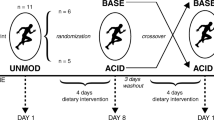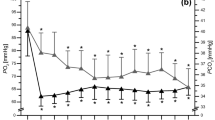Abstract
The aim of this study was to investigate if a pre-exercise alkalosis-mediated attenuation of HSP72 had any effect on the response of the same stress protein after a subsequent exercise. Seven physically active males [25.0 ± 6.5 years, 182.1 ± 6.0 cm, 74.0 ± 8.3 kg, peak aerobic power (PPO) 316 ± 46 W] performed a repeated sprint exercise (EXB1) following a dose of 0.3 g kg−1 body mass of sodium bicarbonate (BICARB), or a placebo of 0.045 g kg−1 body mass of sodium chloride (PLAC). Participants then completed a 90-min intermittent cycling protocol (EXB2). Monocyte expressed HSP72 was significantly attenuated after EXB1 in BICARB compared to PLAC, however, there was no difference in the HSP72 response to the subsequent EXB2 between conditions. Furthermore there was no difference between conditions for measures of oxidative stress (protein carbonyl and HSP32). These findings confirm the sensitivity of the HSP72 response to exercise-induced changes in acid–base status in vivo, but suggest that the attenuated response has little effect upon subsequent stress in the same day.




Similar content being viewed by others
References
Alessio H, Hagerman A, Fulkerson B, Ambrose J, Rice R, Wiley R (2000) Generation of reactive oxygen species after exhaustive aerobic and isometric exercise. Med Sci Sports Exerc 32:1576–1581
Artioli GG, Gualano B, Coelho DF, Benatti FB, Galley AW, Lancha AH (2007) Does sodium-bicarbonate ingestion improve simulated judo performance? Int J Sport Nutr Exer Metabol 17:206–217
Bloomer R, Goldfarb A, Wideman L, McKenzie M, Consitt L (2005) Effects of acute aerobic and anaerobic exercise on blood markers of oxidative stress. J Strength Cond Res 19:276–285
Bloomer R, Falvo M, Fry A, Schilling B, Smith W, Moore C (2006) Oxidative stress response in trained men following repeated squats or sprints. Med Sci Sports Exerc 38:1436–1442
Bloomer R, Davis P, Consitt L, Wideman L (2007a) Plasma protein carbonyl response to increasing exercise duration in aerobically trained men and women. Int J Sports Med 28:21–25
Bloomer R, Fry A, Falvo M, Moore C (2007b) Protein carbonyls are acutely elevated following single set anaerobic exercise in resistance trained men. J Sci Med Sport 10:411–417
Brahimi-Horn C, Pouysségur J (2005) When hypoxia signalling meets the ubiquitin-proteasomal pathway, new targets for cancer therapy. Cr Rev Oncol-Hemat 53:115–123
Carr AJ, Slater GJ, Gore CG, Dawson B, Burke LM (2011) Effect of sodium bicarbonate on [HCO3-], pH, and gastrointestinal symptoms. Int J Sport Nutr Exerc Metab 21:189–194
Christou H, Bailey N, Kluger MS, Mitsialis SA, Kourembanas S (2005) Extracellular acidosis induces heme oxygenase-1 expression in vascular smooth muscle cells. Am J Physiol 288:2647–2652
Finn HT, Brennan SL, Gonano BM, Knox MF, Ryan RC, Siegler JC, Marshall PW (2014) Muscle activation does not increase after a fatigue plateau is reached during 8 sets of resistance exercise in trained individuals. J Strength Cond Res 28:1226–1234
Fisher-Wellman K, Bloomer R (2009) Acute exercise and oxidative stress: A 30 year history. Dyn Med 8:1
Gapen CJ, Moseley PL (1995) Acidosis alters the hyperthermic cytotoxicity and the cellular stress-response. J Thermal Biol 20:321–325
Madden LA, Sandström ME, Lovell RJ, McNaughton L (2008) Inducible heat shock protein 70 and its role in preconditioning and exercise. Amino Acids 34:511–516
Michailidis Y, Jamurtas A, Nikolaidis M, Fatouros I, Koutedakis Y, Papassotiriou I, Kouretas D (2007) Sampling time is crucial for measurement of aerobic exercise-induced oxidative stress. Med Sci Sports Exerc 39:1107–1113
Mitch WE, Medina R, Grieber S, May RC, England BK, Price SR, Bailey JL, Goldberg AL (1994) Metabolic-acidosis stimulates muscle protein-degradation by activating the adenosine triphosphate-dependent pathway involving ubiquitin and proteasomes. J Clin Invest 93:2127–2133
Morillas-Ruiz J, Zafrilla P, Almar M, Cuevas M, Lopez F, Abellan P, Villegas J, Gonzalez-Gallego J (2005) The effects of an antioxidant-supplemented beverage on exercise-induced oxidative stress: Results from a placebo-controlled double-blind study in cyclists. Eur J Appl Physiol 95:543–549
Narasimhan P, Swanson RA, Sagar SM, Sharp FR (1996) Astrocyte survival and hsp70 heat shock protein induction following heat shock and acidosis. Glia 17:147–159
Peart DJ, McNaughton LR, Midgley AW, Taylor L, Towlson C, Madden LA, Vince RV (2011) Pre-exercise alkalosis attenuates the HSP72 response to a single-bout of anaerobic exercise. J Sci Med Sport 14:435–440
Peart DJ, Siegler JC, Vince RV (2012) Practical recommendations for coaches and athletes: a meta-analysis of sodium bicarbonate use for athletic performance. J Strength Cond Res 26:1975–1983
Peart DJ, Kirk RJ, Hillman AR, Madden LA, Siegler JC, Vince RV (2013a) The physiological stress response to high-intensity sprint exercise following the ingestion of sodium bicarbonate. Eur J Appl Physiol 113:127–134
Peart DJ, Kirk RJ, Madden LA, Siegler JC, Vince RV (2013b) The influence of exogenous carbohydrate provision and pre-exercise alkalosis on the heat shock protein response to prolonged interval cycling. Amino Acids 44:903–910
Powers SK, Duarte J, Kavazis AN, Talbert EE (2010) Reactive oxygen species are signalling molecules for skeletal muscle adaptation. Exp Physiol 95:1–9
Price SR, England BK, Bailey JL, Van Vreede K, Mitch WE (1994) Acidosis and glucocorticoids concomitantly increase ubiquitin and proteasome subunit mRNAs in rat muscle. Am J Physiol 267:955–960
Radak Z, Pucsuk J, Boros S, Josfai L, Taylor A (2000) Changes in urine 8-hydroxydeoxyguanosine levels of super-marathon runners during a four-day race period. Life Sci 66:1763–1767
Sandstrom ME, Madden LA, Taylor L, Siegler JC, Lovell RJ, Midgley A, McNaughton L (2009) Variation in basal heat shock protein 70 is correlated to core temperature in human subjects. Amino Acids 37:279–284
Sureda A, Ferrer MG, Mestre A, Tur JA, Pons A (2013) Prevention of neutrophil protein oxidation with vitamins C and E diet supplementation without affecting the adaptive response to exercise. Int J Sport Nutr Exerc Metab 23:31–39
Tauler P, Aguilo A, Gimeno I, Fuentespina E, Tur J, Pons A (2003) Influence of vitamin c diet supplementation on endogenous antioxidant defences during exhaustive exercise. Pflugers Arch 446:658–664
Taylor L, Midgley A, Chrismas B, Hilman A, Madden L, Vince R, McNaughton L (2010) Daily hypoxia increases basal monocyte HSP72 expression in healthy human subjects. Amino Acids 40:393–401
Taylor L, Hillman A, Midgley A, Peart D, Chrismas B, McNaughton L (2012) Hypoxia-mediated prior induction of monocyte-expressed HSP72 and HSP32 provides protection to the disturbances to redox balance associated with human sub-maximal aerobic exercise. Amino Acids 43:1933–1944
Vince R, Oliver K, Midgley A, McNaughton L, Madden L (2010) In vitro heat shock of human monocytes results in a proportional increase of inducible HSP70 expression according to the basal content. Amino Acids 38:1423–1428
Whitham M, Halson SL, Lancaster GI, Gleeson M, Jeukendrup AE, Blannin AK (2004) Leukocyte heat shock protein expression before and after intensified training. Int J Sports Med 25:522–527
Acknowledgments
The authors wish to thank those who volunteered for the study, and declare that the research project was internally funded.
Author information
Authors and Affiliations
Corresponding author
Ethics declarations
Ethical approval
All procedures performed in studies involving human participants were in accordance with the ethical standards of the institutional and/or national research committee and with the 1964 Helsinki Declaration and its later amendments or comparable ethical standards.
Conflict of interest
The authors declare that they have no conflict of interest.
Additional information
Handling Editor: E. Rawson.
Rights and permissions
About this article
Cite this article
Peart, D.J., Kirk, R.J., Madden, L.A. et al. Implications of a pre-exercise alkalosis-mediated attenuation of HSP72 on its response to a subsequent bout of exercise. Amino Acids 48, 499–504 (2016). https://doi.org/10.1007/s00726-015-2103-1
Received:
Accepted:
Published:
Issue Date:
DOI: https://doi.org/10.1007/s00726-015-2103-1




